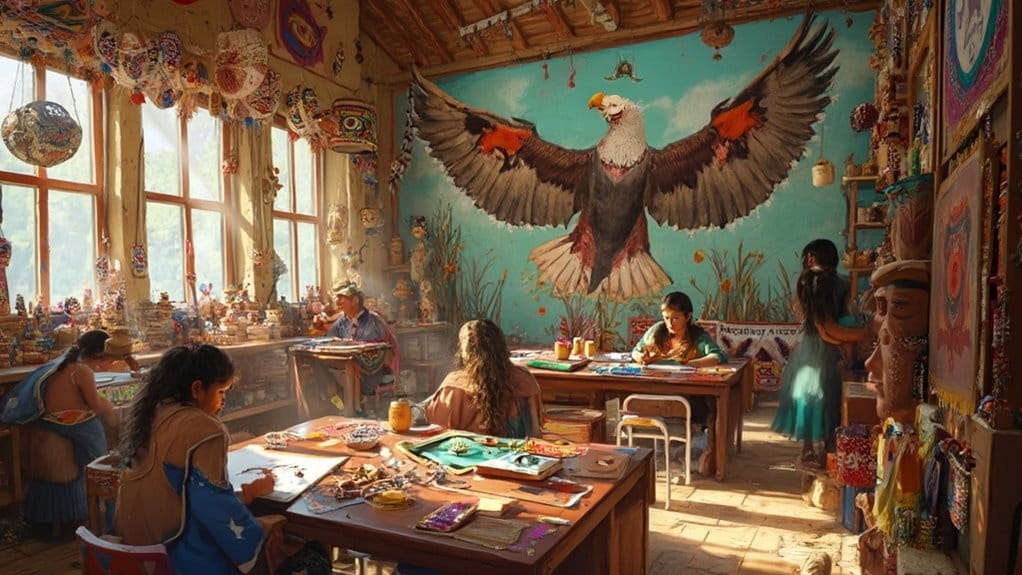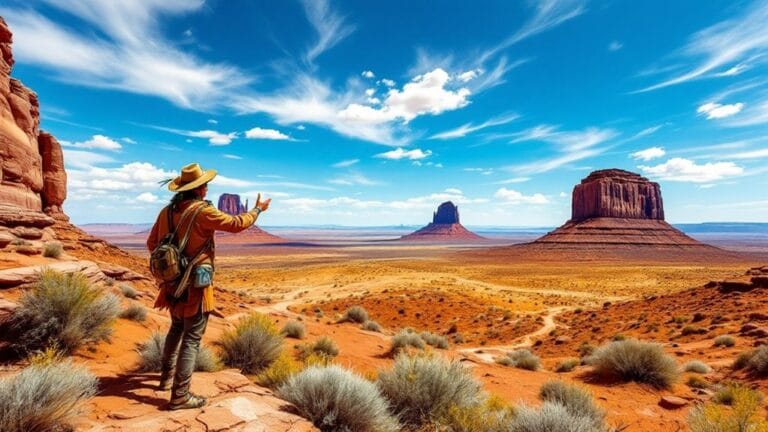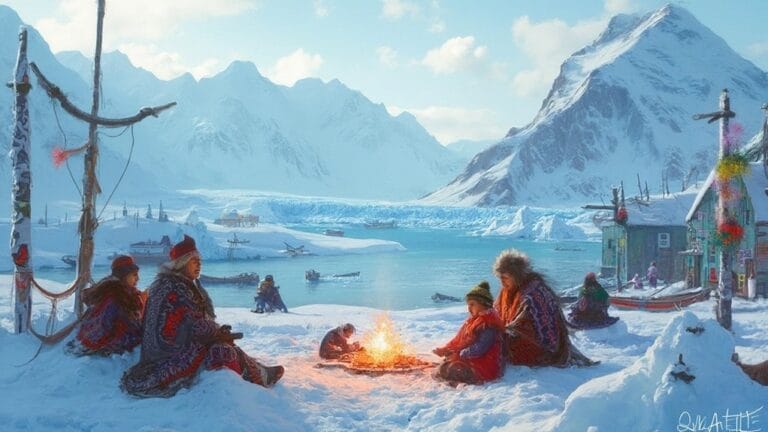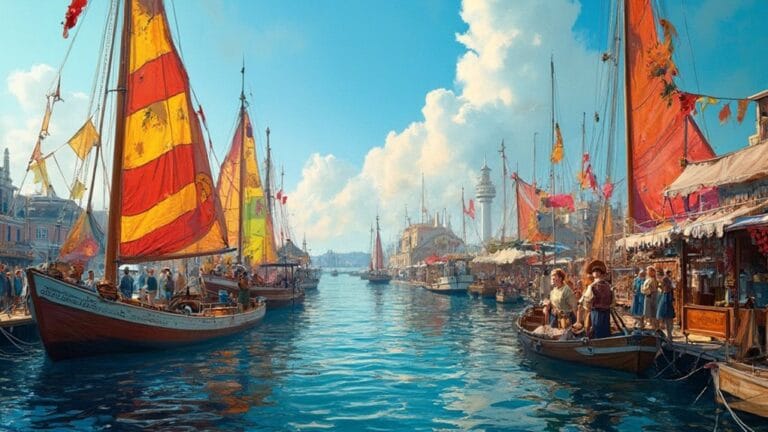First Nations art classes in BC are like stepping into a vibrant world where creativity flows from generations of stories. You’ll learn cool skills in carving, weaving, painting, and even dance that connect you deeply to the land and culture. Each class offers unique insights into traditions, whether you’re creating intricate Okanagan pictographs or exploring modern techniques that tackle contemporary issues. Plus, you get to interact with passionate artists and elders who share their wisdom and techniques. It’s more than just art; it’s a pathway into the heart of Indigenous identity that’s truly eye-opening. Stick around, and you’ll uncover even more fascinating details!
Key Takeaways
- First Nations art classes in BC teach traditional techniques like carving, weaving, and painting, emphasizing cultural narratives and spiritual connections.
- Students explore various Indigenous art styles unique to specific tribes and regions, fostering appreciation for diverse artistic expressions.
- Classes incorporate community engagement, encouraging collaboration and mentorship between experienced artists and learners to preserve cultural knowledge.
- Educational resources guide teachers in integrating Indigenous content, enriching the curriculum with hands-on experiences and critical thinking activities.
- Funding opportunities and support programs help students and emerging artists develop their skills and sustain their artistic practices.
Overview of First Nations Art Classes
First Nations art classes in BC often serve as a vital link between generations, ensuring that traditional practices are preserved and passed down. Imagine walking into a classroom filled with the vibrant colors of paint and the earthy scents of natural materials. You’re not just learning to create; you’re part of a cultural exchange that’s rich with history and meaning. These classes, like those at the Freda Diesing School of Northwest Coast Art, invite you to explore artistic innovation while grounding you in timeless traditions.
You’ll find experienced artists and elders sharing their wisdom, teaching you techniques that have been honed over centuries. It’s like having a treasure map to your cultural heritage, with every brush stroke and carving revealing stories of your ancestors. Plus, you’re encouraged to experiment and make it your own, blending the old with the new. This experiential learning not only fosters individual growth but also promotes community engagement as a vital aspect of the arts.
And let’s face it: there’s something magical about creating art that speaks to who you are and where you come from. The laughter, the shared moments, and the pride in your work—it all connects you to a community that values both the past and the future. So, engage deeply and experience this beautiful journey!
Key Art Disciplines Taught
Exploring the key art disciplines taught in First Nations art classes reveals a rich tapestry of cultural expression. You’ll immerse yourself in traditional and contemporary arts making processes, where dances, songs, and stories come alive. It’s intriguing how these artistic processes serve purposes rooted in ceremonies and daily life.
Visual arts are a big highlight, too, featuring carving, weaving, and body art—each piece tells a story and embodies cultural identity. Performance arts, like music and dance, let you feel the heartbeat of a community, expressing spiritual connections. In particular, Northwest Coast First Nations art plays a significant role in illustrating the diverse cultural narratives of these communities.
Don’t forget media arts, where technology meets creativity, and literary arts, which include enchanting storytelling and poetry. You might even find yourself inspired by the intricate details of sculpture and carving, especially those iconic totem poles.
As you move through the grades, you’ll explore everything from Okanagan pictographs in elementary school to the modern Northwest Coast styles in middle school, learning about artists like Robert Davidson along the way. Each discipline invites you to connect more deeply with First Nations cultural expressions, making every lesson an adventure of discovery.
Educational Resources Available
Access to a wealth of educational resources makes learning about First Nations art in BC both engaging and enriching. You’ll discover an array of materials designed to make your experience memorable. The First Nations Education Steering Committee (FNESC) offers fantastic resources for curriculum integration, helping you weave Indigenous content into various subjects seamlessly. With tools like the Learning First Peoples program, you can explore art in a broader context.
The Government of BC also provides resources, including the Indigenous Education Resource Inventory. This extensive list is like having a treasure map leading you to valuable information. Don’t forget the B.C. First Nations Studies Teacher’s Guide, which is packed with local art activities that spark creativity. Additionally, schools in BC that are First Nations can qualify for funding to support professional artist fees through the ARTISTS.EDU program, enhancing the educational experience.
Plus, if you’re interested in hands-on experiences, check out the online workshops! They’re perfect for diving deeper into specific art forms and techniques. And let’s not overlook the University of British Columbia’s First Nations and Indigenous Art Research Guide. This resource offers a treasure trove of books and digital content that will inspire you. With so many resources at your fingertips, you’re set for an enriching journey into the world of First Nations art!
Funding Opportunities for Artists
For artists in British Columbia, the landscape of funding opportunities is rich and diverse, offering support tailored specifically for Indigenous creators. You’ve got amazing resources like the BC Arts Council, which provides various grants, including Individual Arts Grants that can help you engage with your next big project. If you’re looking for something more specific, the First Peoples’ Cultural Council offers programs designed just for you, with up to $20,000 available through their Individual Artists Program. Imagine expanding your portfolio or exploring new techniques with that kind of support!
But let’s not forget about the importance of the grant application itself. Understanding the funding eligibility criteria can make or break your chances. Don’t worry; the Indigenous Arts Collective of Canada is here to guide you through the maze of opportunities. Whether you’re a seasoned artist or just starting out, there’s funding waiting for you. From scholarships to mentorship programs, these resources can help you grow your artistry and connect with your community. Additionally, participating in programs like the First Nations Fine Arts Certificate can enhance your skills and make your application stand out. So, take a deep breath, gather your ideas, and get ready to make your mark—there’s a world of support out there just for you!
Teaching Indigenous Art in Schools
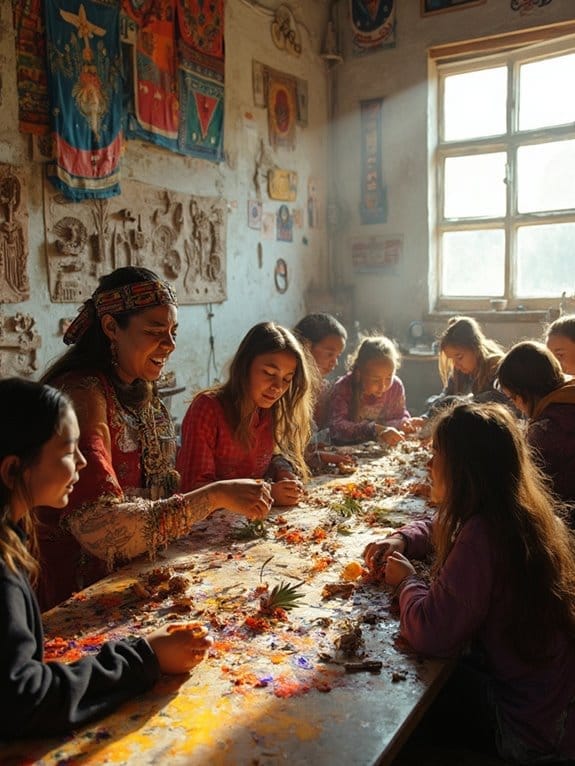
Integrating Indigenous art into school curricula enriches students’ understanding of diverse cultures and histories. When you immerse yourself in the world of Indigenous art, you’re not just learning about pretty paintings; you’re discovering deep-rooted cultural protocols and the stories behind every brushstroke. The redesigned BC curriculum does a fantastic job of weaving Indigenous perspectives into various subjects, making art an essential part of the conversation.
Imagine having a local artist come into your classroom, sharing their experiences and demonstrating techniques that have been passed down through generations. It’s a hands-on way to engage with the community and really feel the pulse of Indigenous culture. With critical thinking and reflective journals, you’re encouraged to explore your thoughts and perspectives, making the learning experience more personal. Additionally, initiatives like the Learning Series aim to equip Teaching Artists with facilitation skills that enhance engagement with students.
Plus, programs like the Arts Integration Learning Lab are designed to give teachers the tools they need to connect with Indigenous artists effectively. They foster a space where creativity and education intersect, ensuring that students not only learn about art but also about respect and understanding. So, whether it’s through dances, songs, or traditional crafts, teaching Indigenous art in schools opens up a vibrant world of learning!
Cultural Importance of Indigenous Art
Indigenous art is much more than just visually appealing creations; it embodies deep spiritual connections and cultural narratives that resonate with both the artists and their communities. When you immerse yourself in Indigenous art, you’re not just looking at pretty patterns; you’re witnessing stories passed down through generations, each piece a reflection of cultural resilience.
Think about it—every artwork reflects the bond between the artist, their land, and those ancestral spirits. It’s a powerful reminder of the ancient wisdom that’s been preserved through artistic expression. Plus, creating art often involves communities coming together, which strengthens social ties and helps share important cultural knowledge and customs.
You’ll notice a rich diversity in styles, from pottery to beadwork, each unique to different tribes. Additionally, Indigenous art has origins dating back to the last Ice Age, showcasing the longstanding connection between art and culture in these communities. And contemporary artists are doing something amazing—they’re reimagining traditional forms using modern materials, proving that Indigenous art can evolve while still honoring its roots.
Frequently Asked Questions
What Are the Prerequisites for Enrolling in First Nations Art Classes?
To enroll in First Nations art classes, you should have an interest in cultural significance and artistic techniques. While no prior experience’s required, understanding cultural protocols and sensitivity’s highly recommended for a richer learning experience.
How Long Do First Nations Art Programs Typically Take to Complete?
First Nations art programs typically range from a few weeks to a year. You’ll explore cultural significance and artistic techniques, engaging in hands-on projects that deepen your appreciation and understanding of Indigenous art and traditions.
Are There Any Age Restrictions for Students in These Art Programs?
There aren’t strict age restrictions for First Nations art programs, promoting age inclusivity. You’ll find opportunities for community engagement across various age groups, allowing everyone to explore Indigenous art and culture together in meaningful ways.
Can Non-Indigenous Artists Participate in First Nations Art Classes?
Can you imagine engaging deeply with a community’s heritage? Non-Indigenous artists can participate in First Nations art classes, but you’ll need to respect cultural protocols and understand the importance of avoiding cultural appropriation.
What Career Opportunities Are Available for Graduates of These Programs?
Graduates can explore career opportunities like cultural policy analysts, community program coordinators, or art educators. These roles emphasize cultural preservation and artistic expression, ensuring Indigenous perspectives thrive in education, community, and arts sectors.

